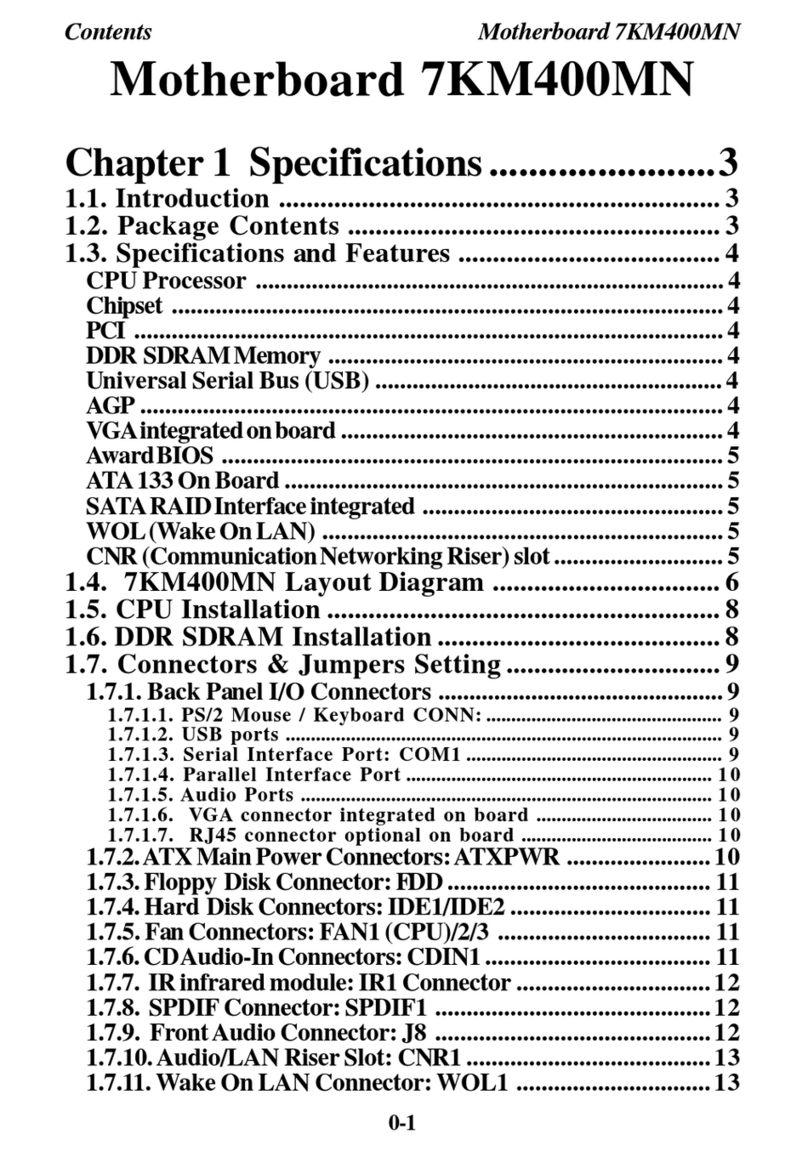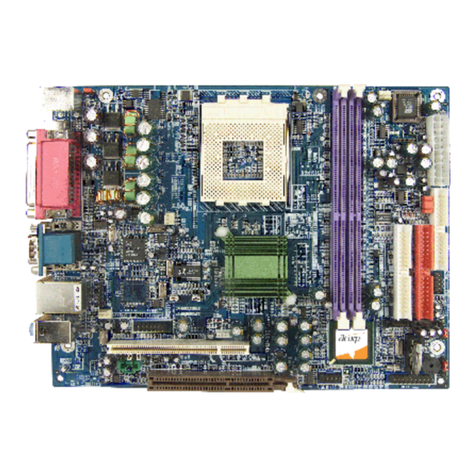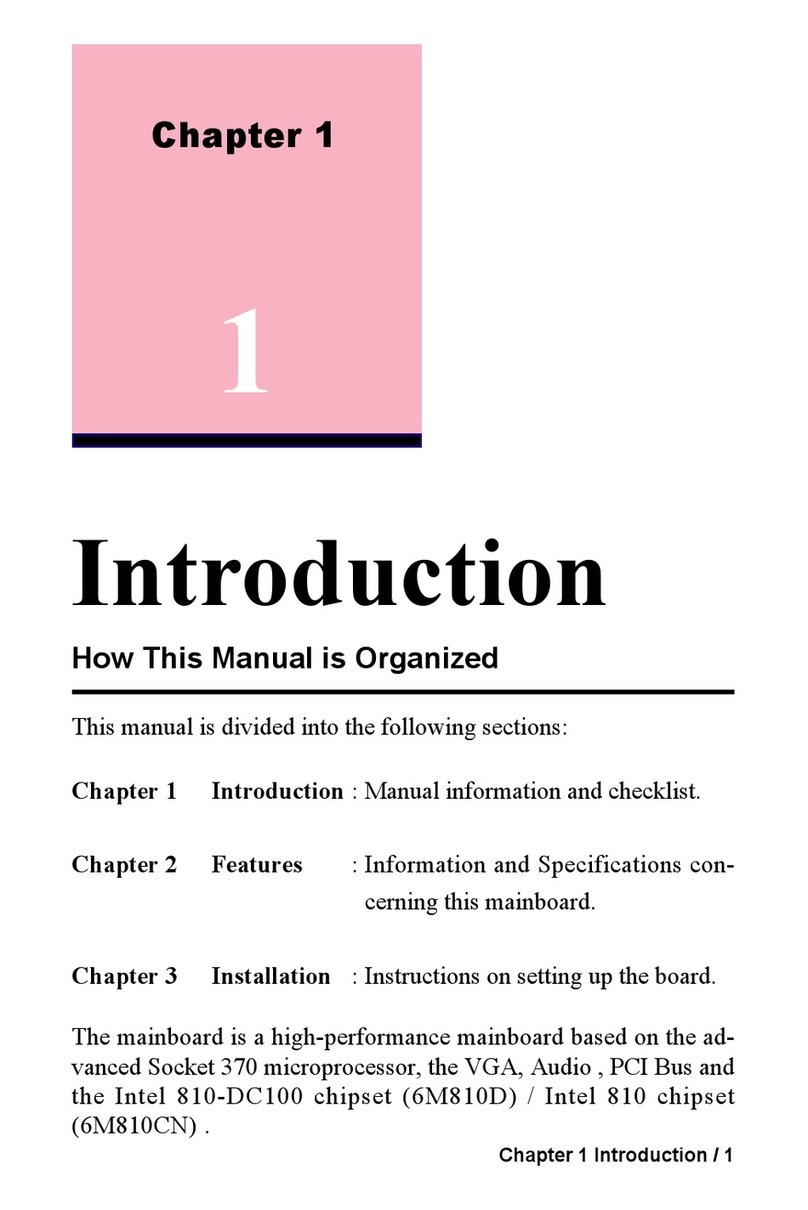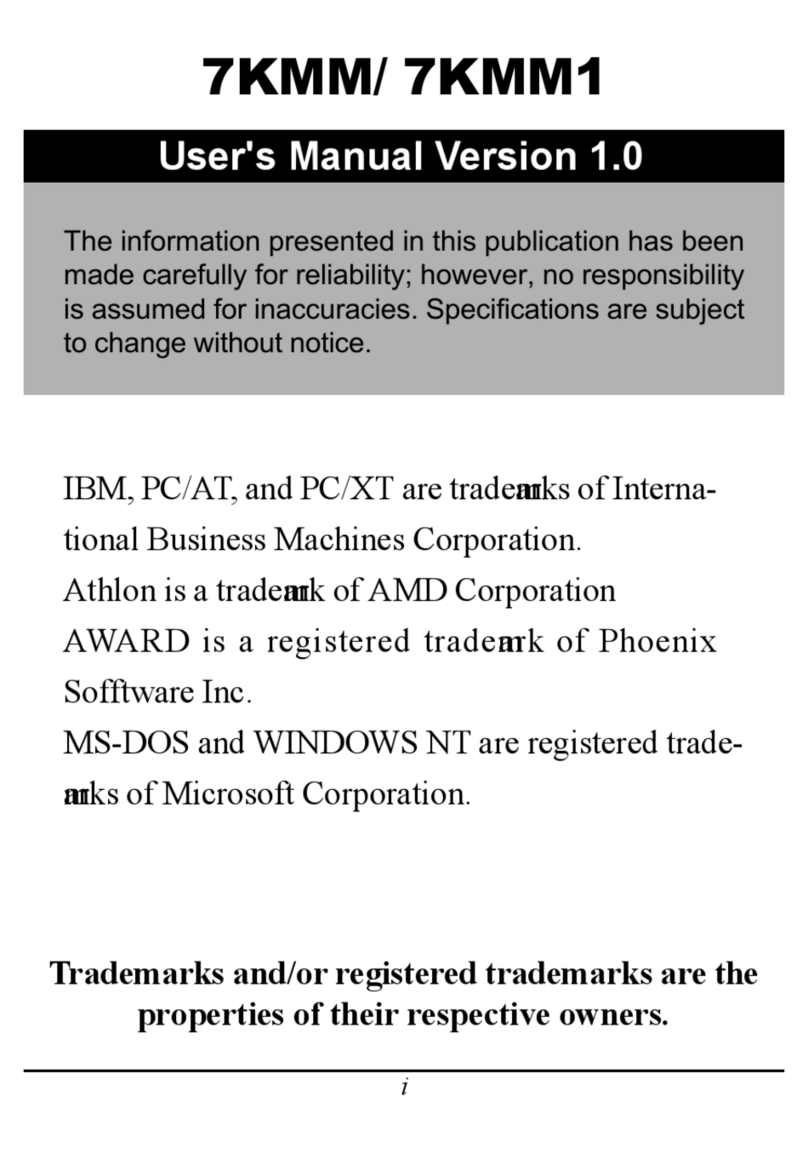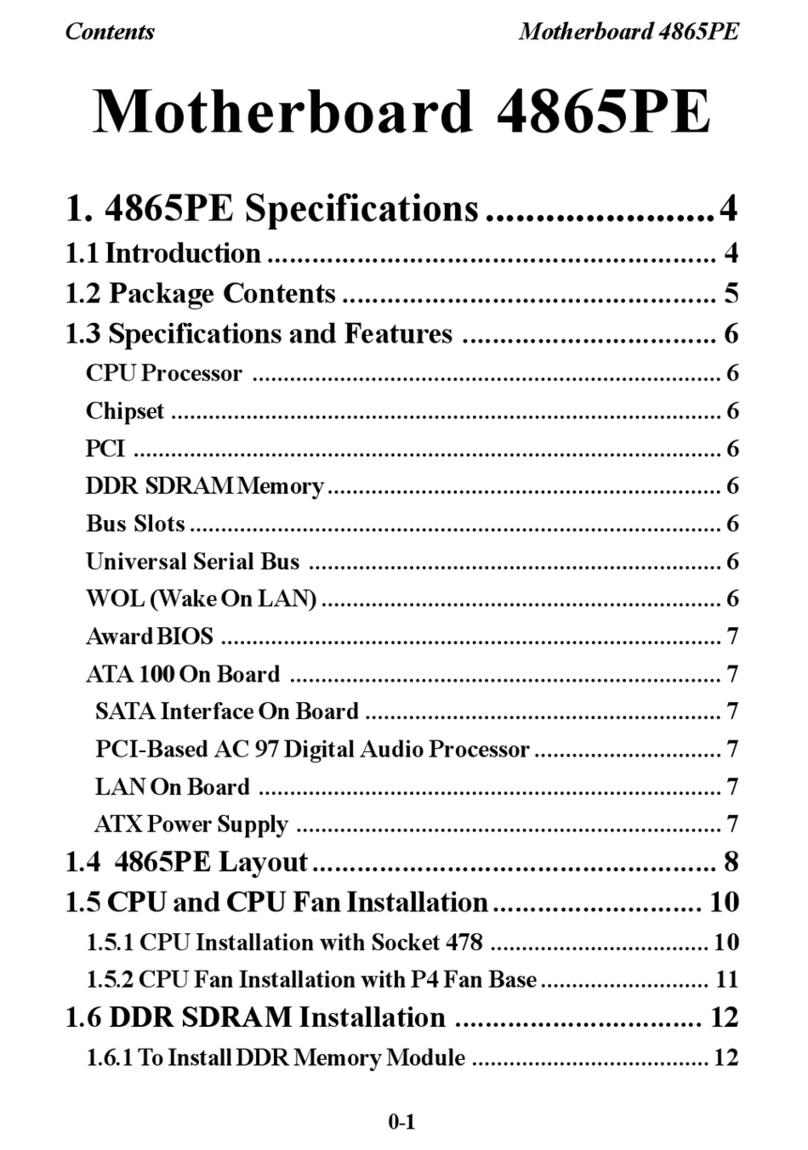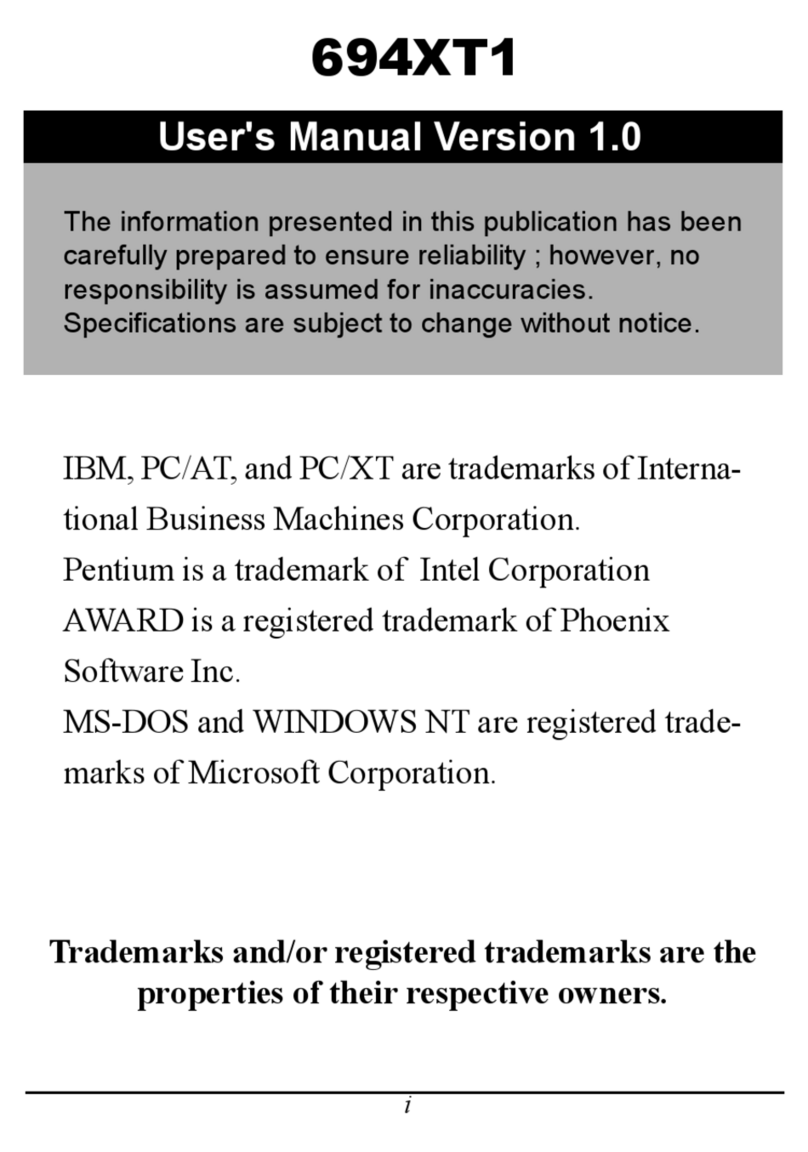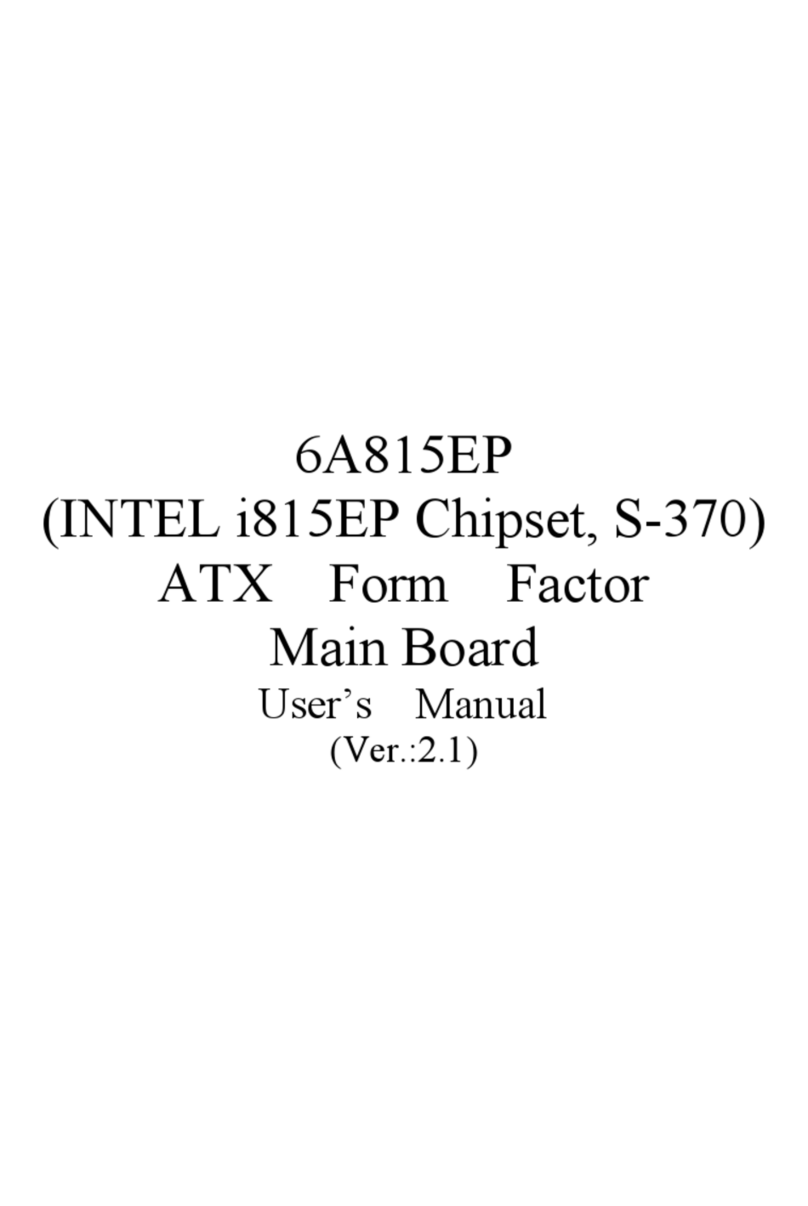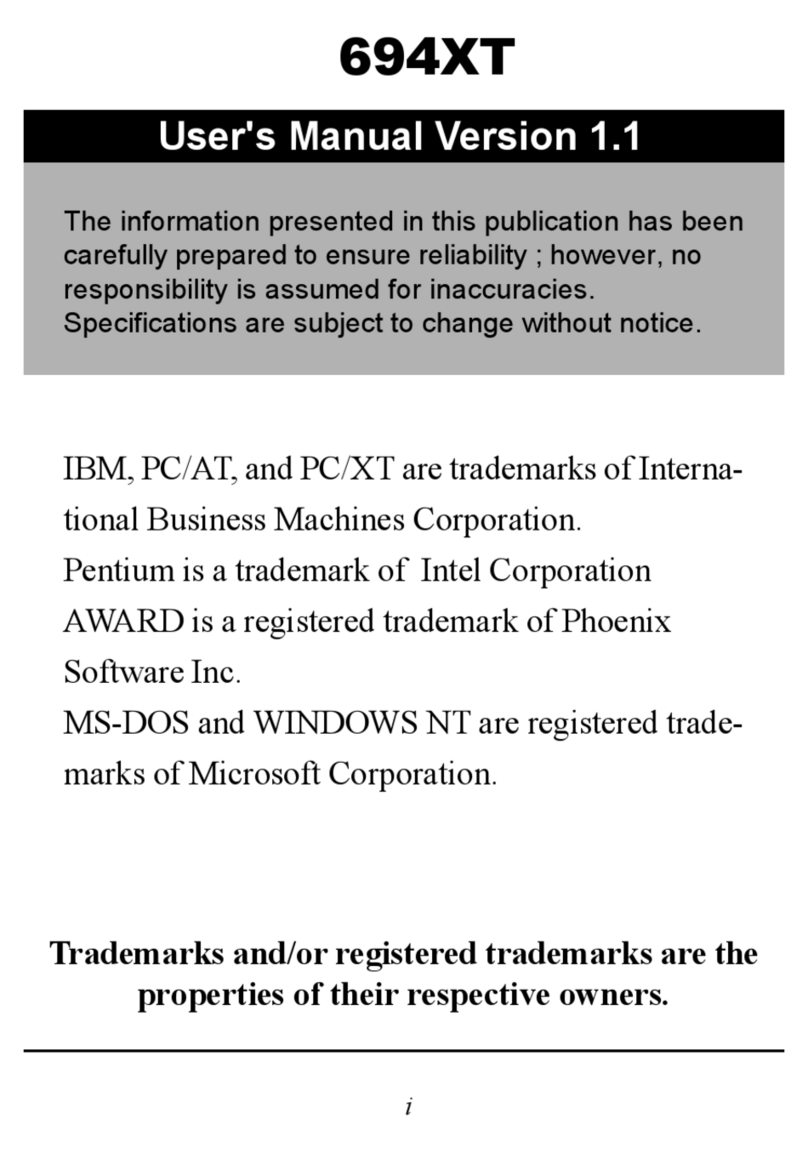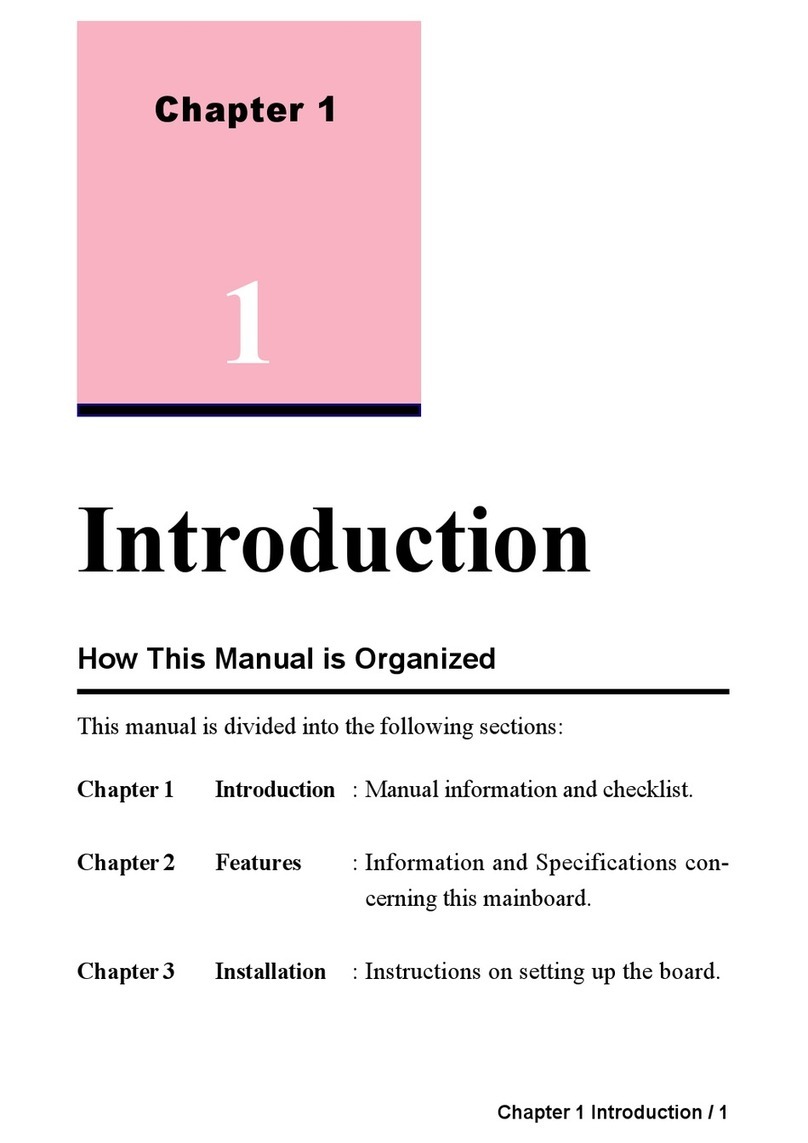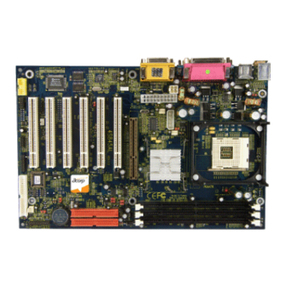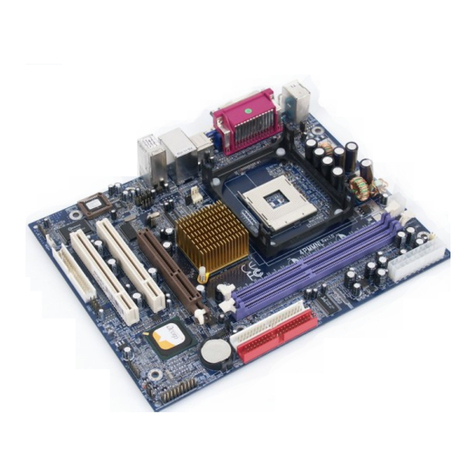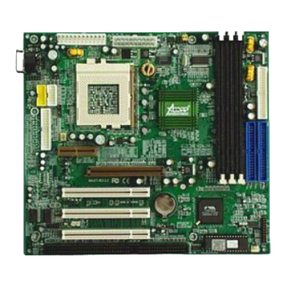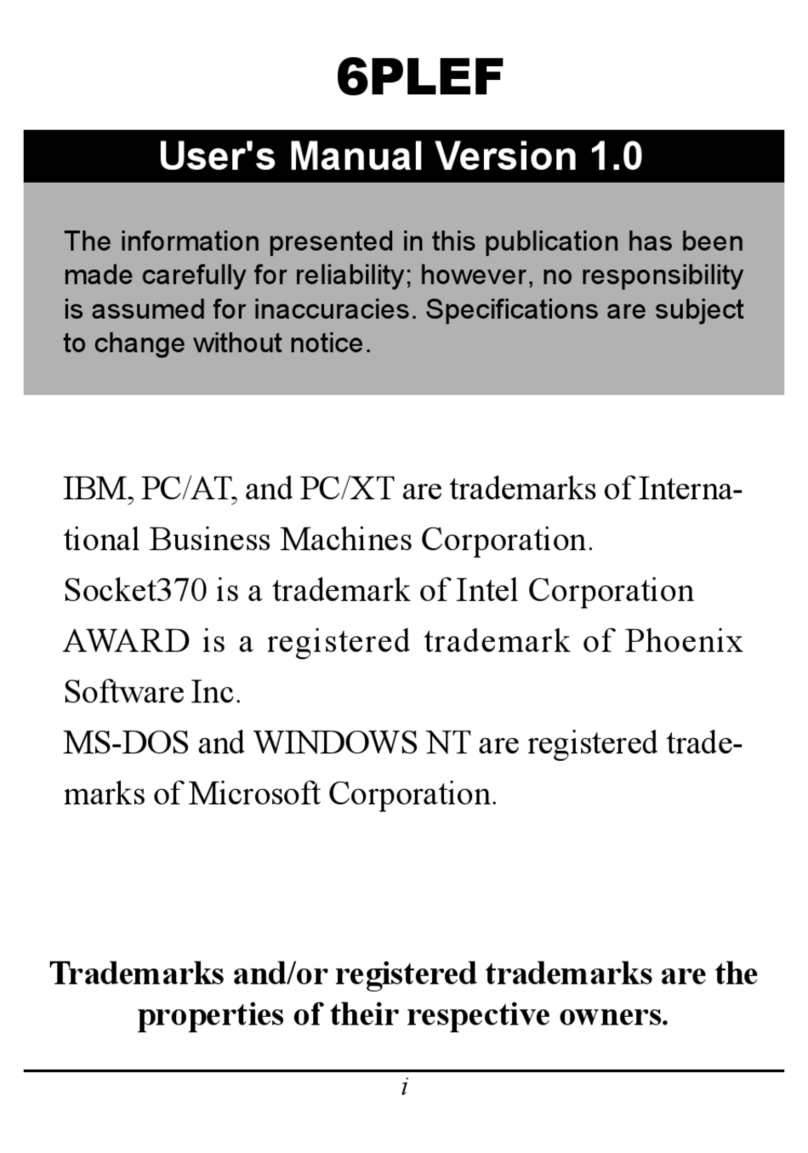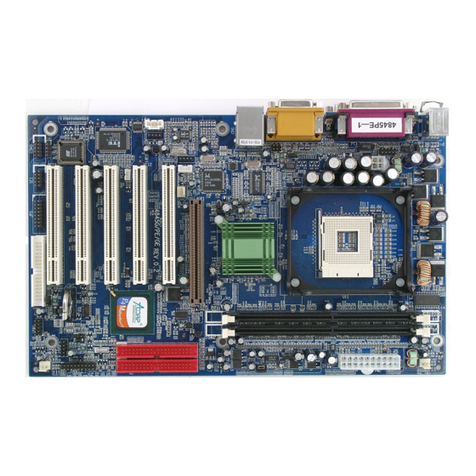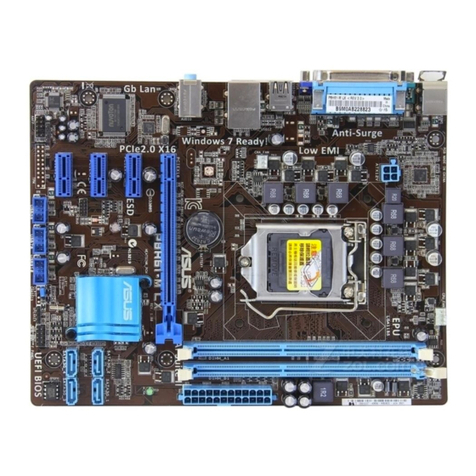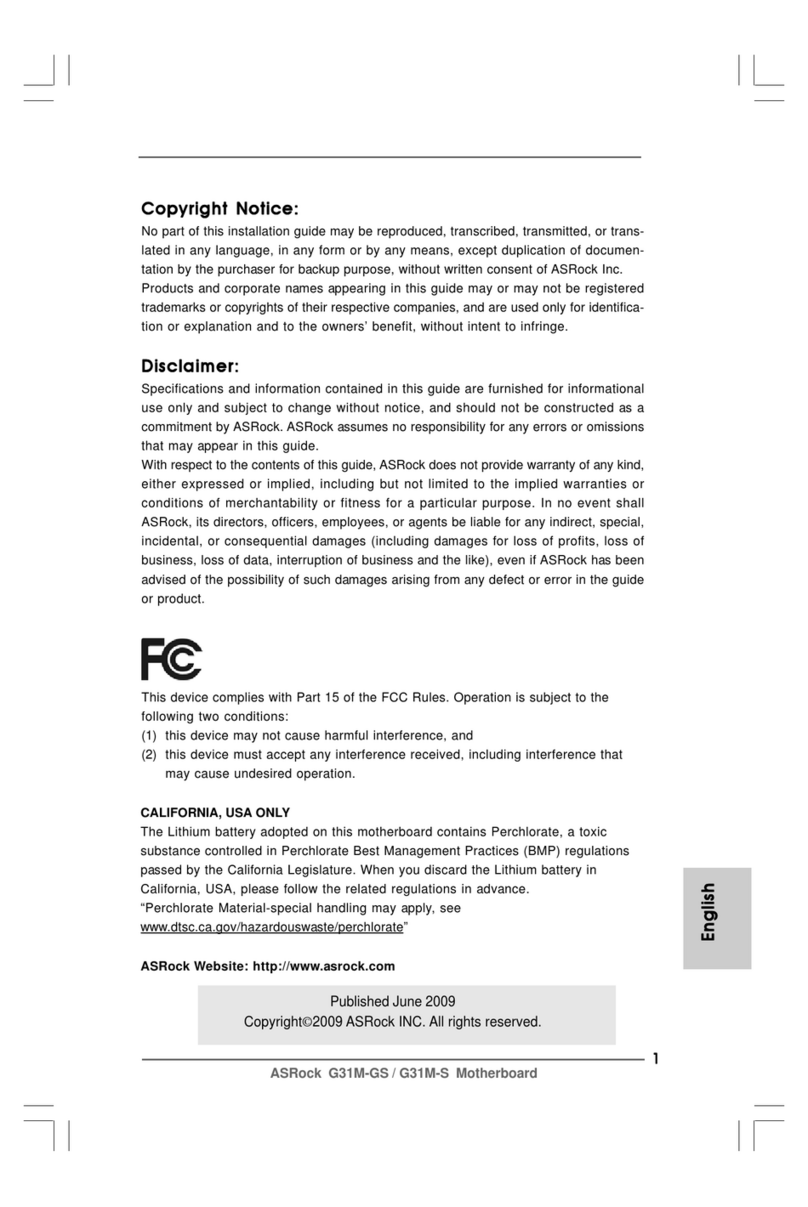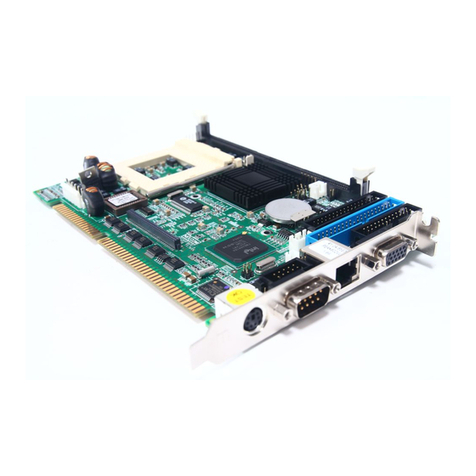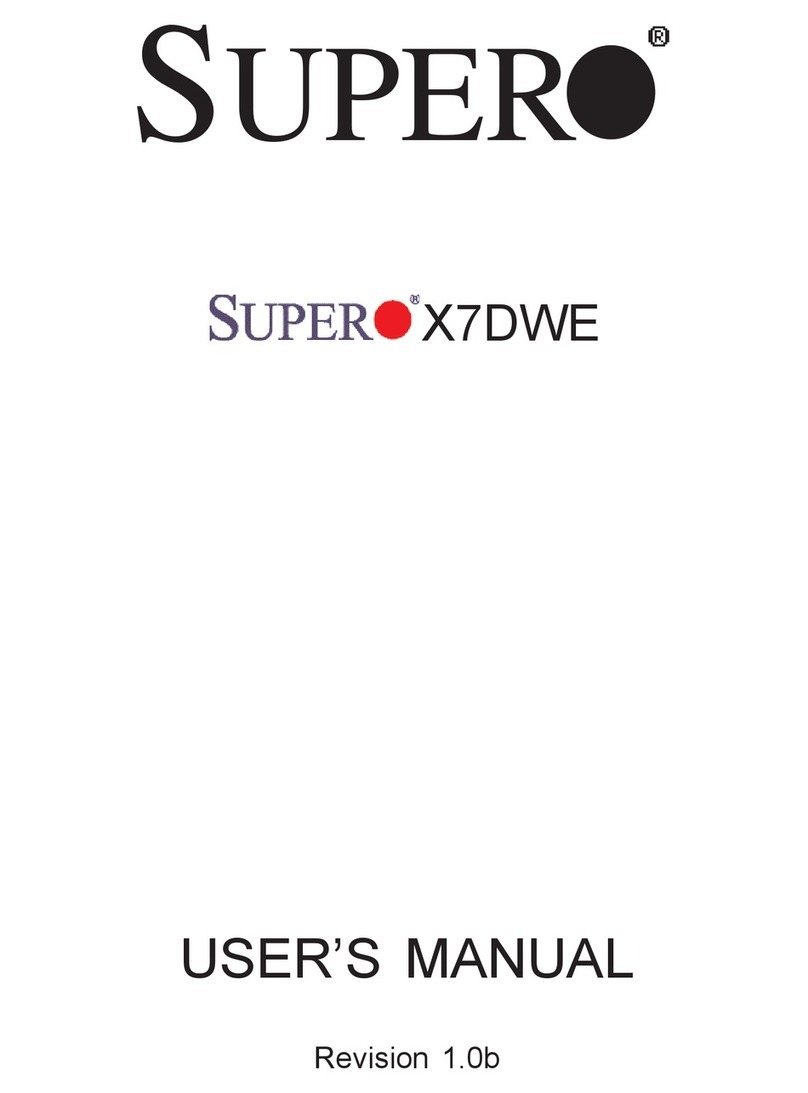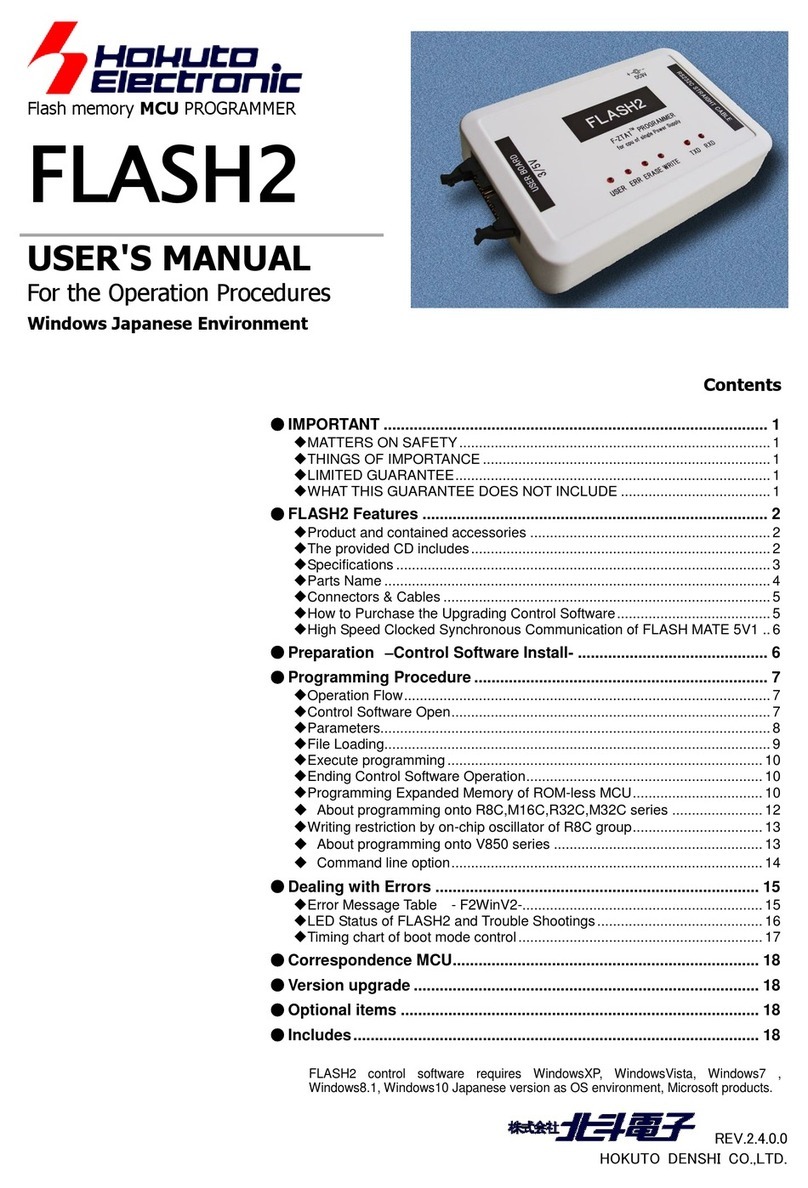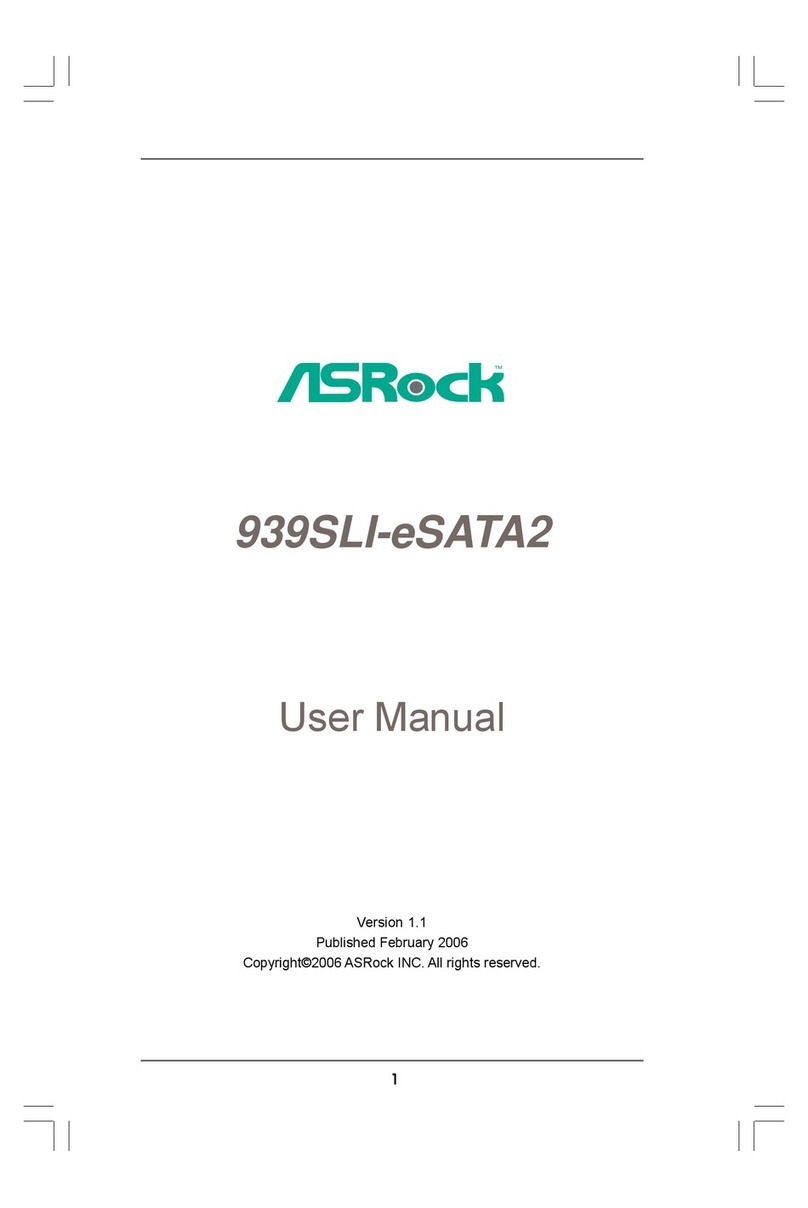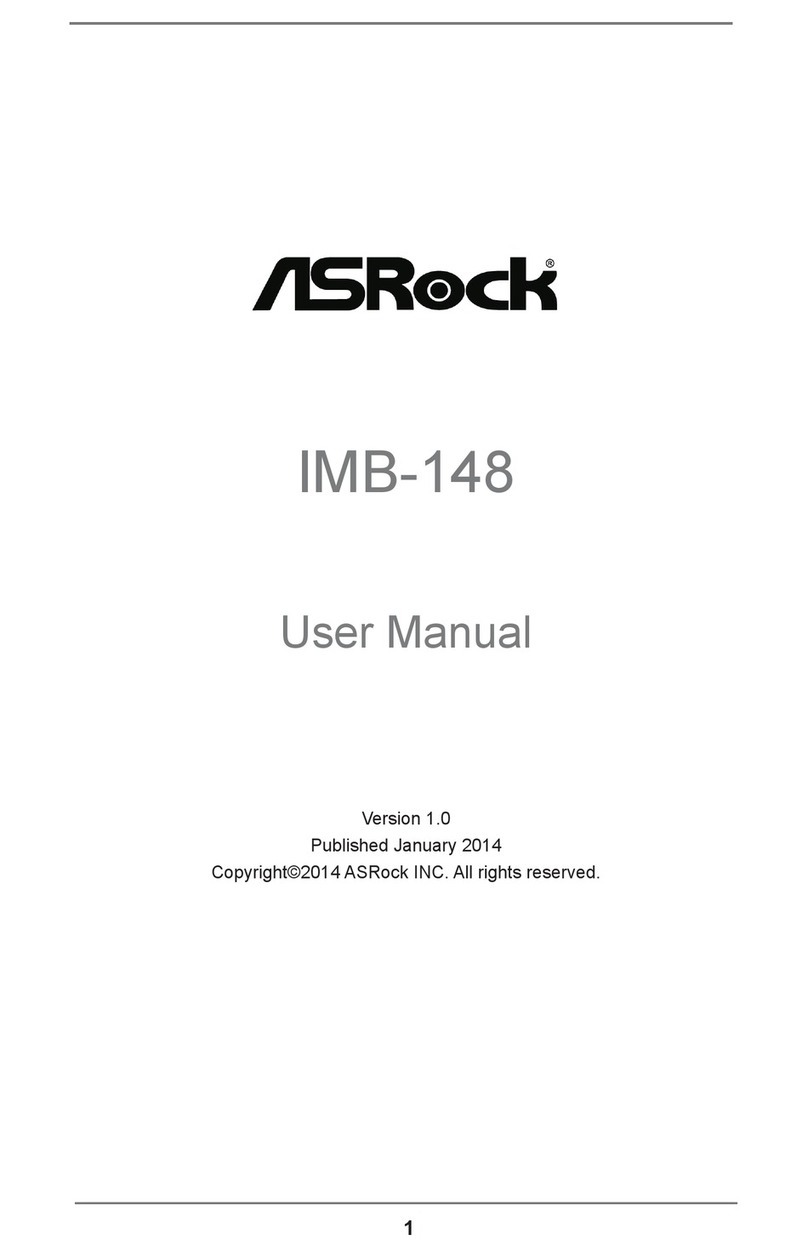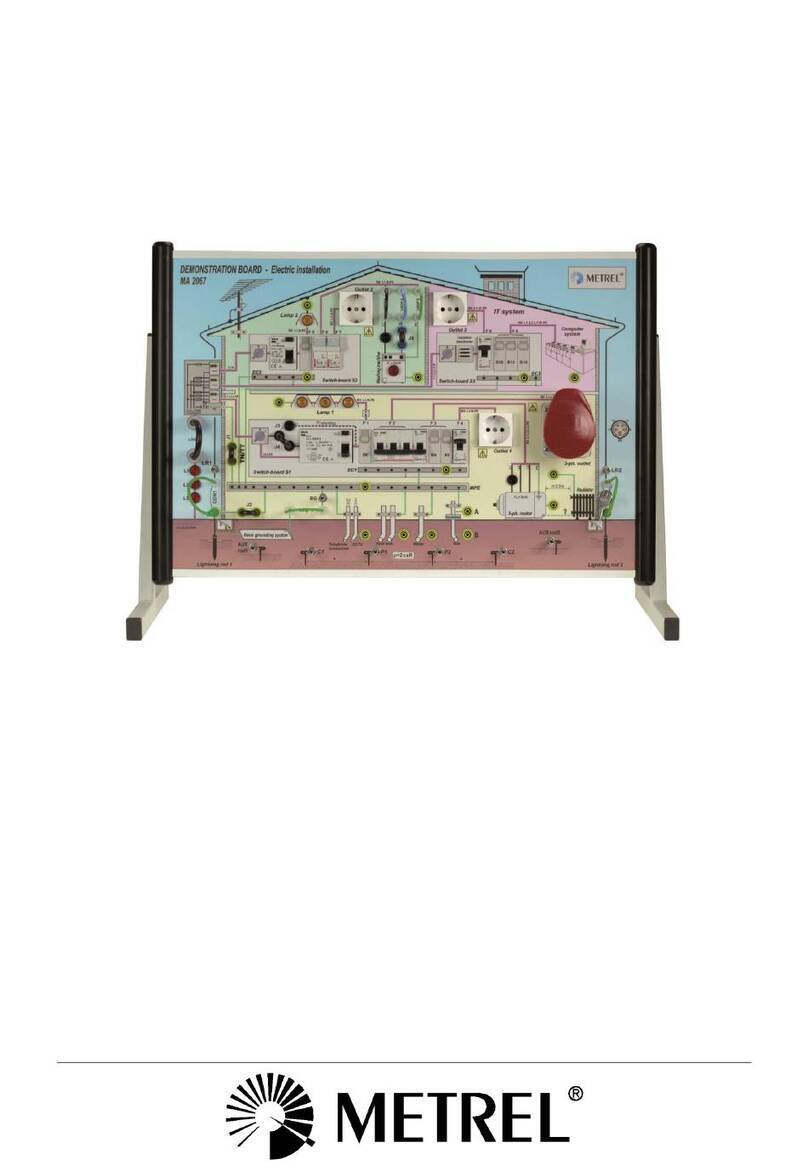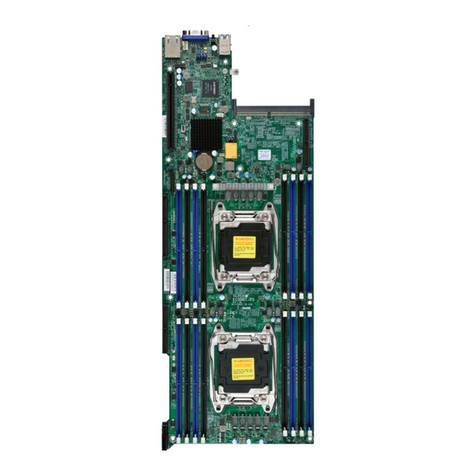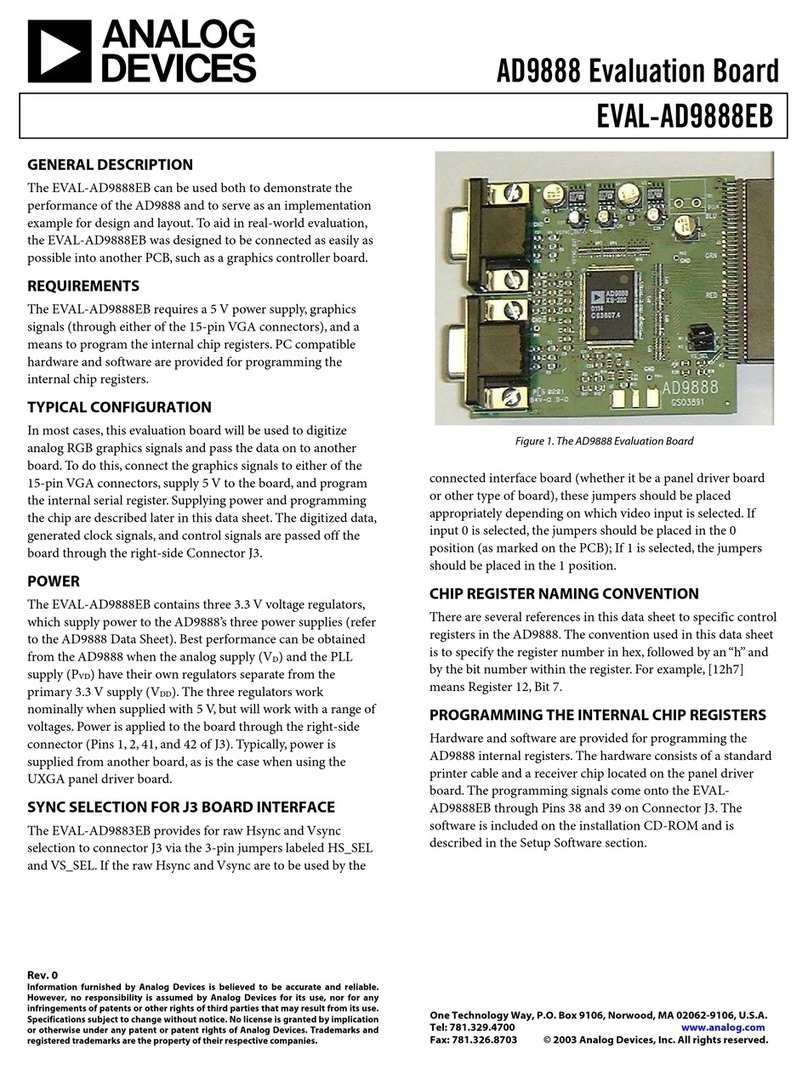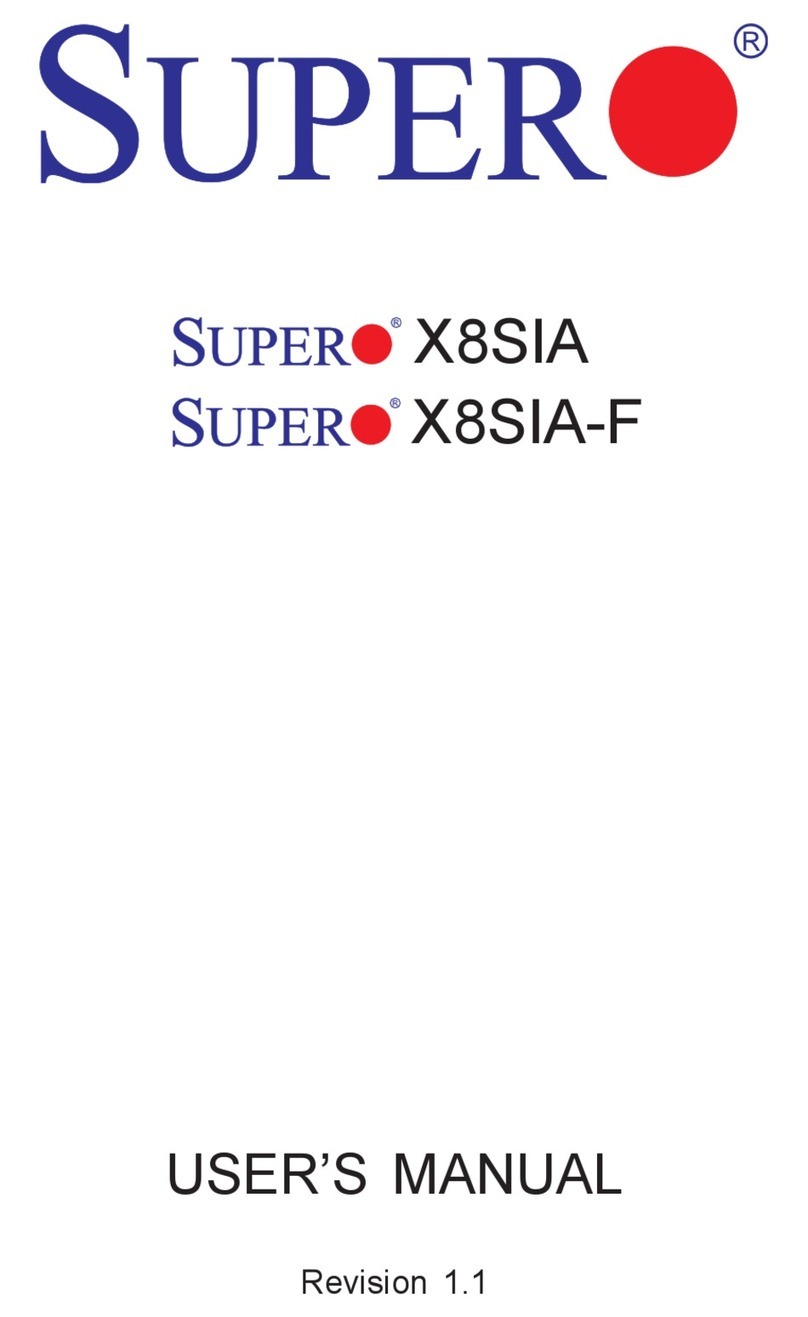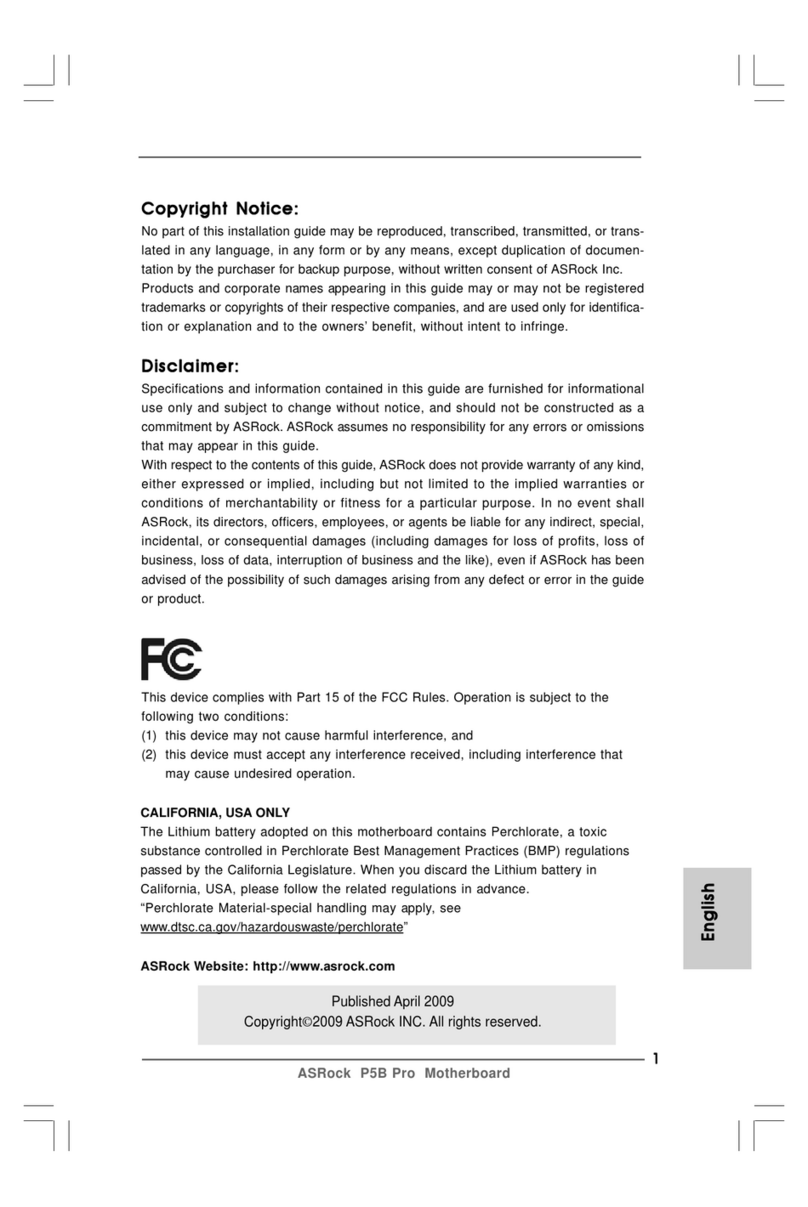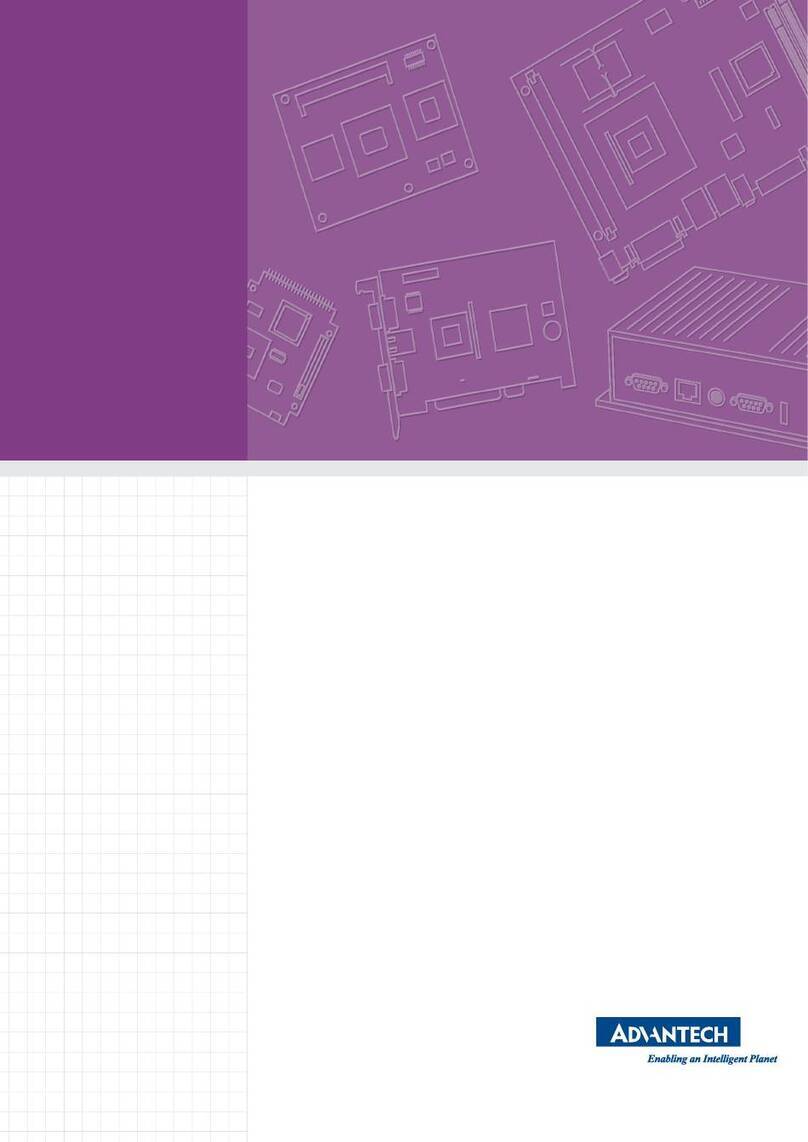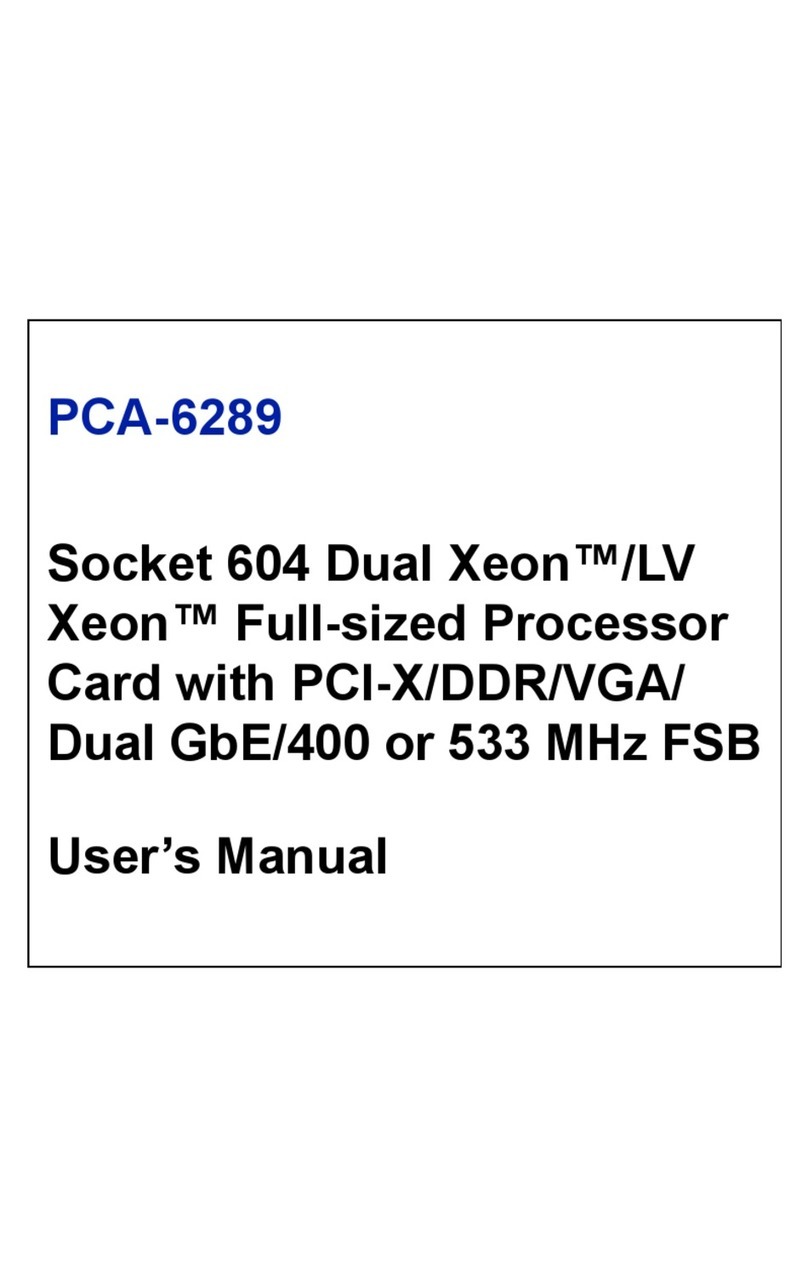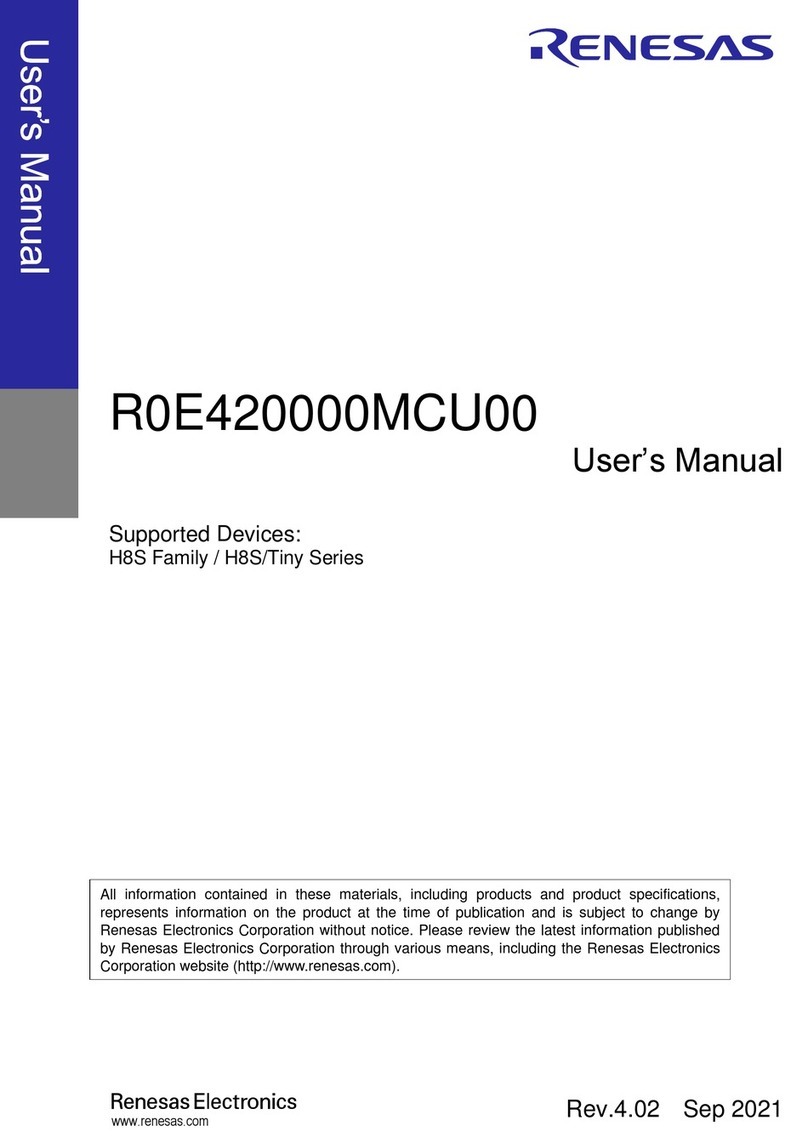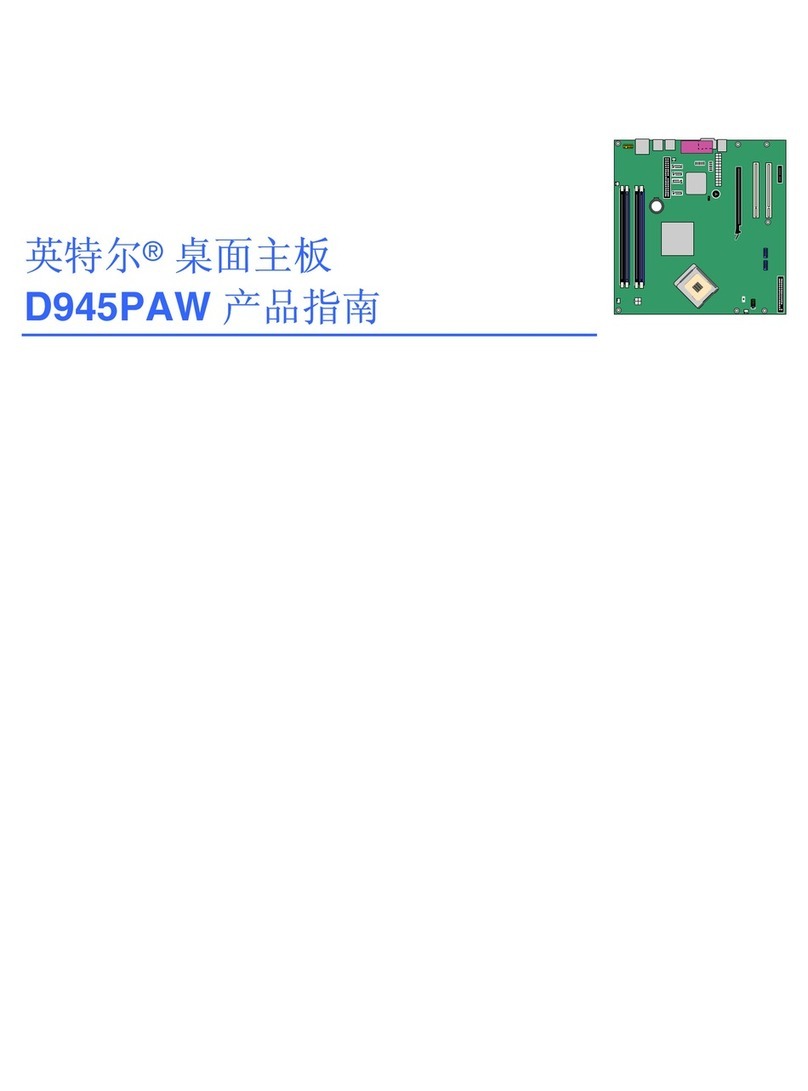Acorp 6V8633A User manual

The information presented in this publication has been
carefully prepared to ensure reliability ; however, no
responsibility is assumed for inaccuracies.
Specifications are subject to change without notice.
IBM, PC/AT, and PC/XT are trademarks of Interna-
tional Business Machines Corporation.
Socket370 is a trademark of Intel Corporation
AWARD is a registered trademark of Phoenix
Software Inc.
MS-DOS and WINDOWS NT are registered
trademarks of Microsoft Corporation.
Trademarks and/or registered trademarks are the
properties of their respective owners.
User's Manual Version 1.0
6V8633A
i

Table of Contents
IntrnctctinnIntrnctctinn
IntrnctctinnIntrnctctinn
Intrnctctinn
1. Mnthdranarc Ddrcriotinn1. Mnthdranarc Ddrcriotinn
1. Mnthdranarc Ddrcriotinn1. Mnthdranarc Ddrcriotinn
1. Mnthdranarc Ddrcriotinn
1.1 Fdattrdr
1.1.1 Harcward 1-1
1.1.1Snetward 1-4
1.1.3 Attachmdntr1-4
1.1Mnthdranarc Inrtallatinn
1.1.1 Mnthdranarc Mao1-5
1.1.1Mnthdranarc Layntt1-6
1.3 Mnthdranarc Cnnndctnrr
1.3.1 Frnnt Pandl Cnnndctnrr(PANEL(1-8
1.3.1Flnooy Dirk Cnnndctnr(FDD(1-9
1.3.3 Harc Dirk Cnnndctnrr(IDE1.IDE1( 1-9
1.3.4 ATX 10-oin Pnwdr Cnnndctnr(ATX(1-10
1.3.5 Inerardc Cnnndctnr(IR(1-10
1.4 Back Pandl Cnnndctnrr
1.4.1 PS.1 Mntrd.Kdyanarc CNNN. 1-11
1.4.1USB Cnnndctnrr1-11
1.5 Sdrial anc Paralldl Intdreacd onrtr1-13
1.6 CPU Inrtallatinn
1.6.1 CPU Inrtallatinn Prnctct(Snckdt 360(1-15
1.6.1CPU Frdqtdncy Sdtting(JCLK(1-16
1.6Jtmodr Sdtting
1.6.1 CPU Fan Cnnndctnr(FAN1.1.3(1-16
1.6.1Wakd-Nn-Mncdm Hdacdr(WNM(1-18
1.6.3 Wakd-Nn-LAN Hdacdr(WNL(1-18
1.6.4 CNDEC Sdldctinn(J1( 1-18
1.6.5 CMNS Ftnctinn Sdldct(CMNS(1-18
1.6.6 CharricIntrtrinn Cnnndctnr(JCASE(1-19
1.6.6IrDA Cnnndctnr(IR(1-19
ii

Table of Contents
1.8 DDR SDRAM Inrtallatinn
1.8.1 DDR 1-10
1.8.1Hnw tninrtall aDDR Mnctld 1-10
1.9 AtcinStaryrtdm
1.9.1 CD-Atcin-IN Cnnndctnrr(CDIN1.CDIN1( 1-11
1.10 Smart Pandl Nnanarc Cnnndctnr (notinn((notinn(
(notinn((notinn(
(notinn(
1.10.1 Pnrt 80 Ddatg Ftnctinn(ERR(1-13
1.10.1Sdcnnc BINS Cnnndctnr(BINS(1-13
1.10.3 Smart Pandl Dirolay Ftnctinn(JFP(1-13
1. BINS Sdtto1. BINS Sdtto
1. BINS Sdtto1. BINS Sdtto
1. BINS Sdtto
1.1 Main Mdnt1-4
1.1Stancarc CMNS Fdattrdr1-6
1.3 Acuancdc BINS Fdattrdr1-10
1.4 Acuancdc Chiordt Fdattrdr1-14
1.5 Intdgratdc Pdriohdralr1-18
1.6 Pnwdr Managdmdnt Sdtto1-14
1.6PnP.PCI Cnneigtratinnr1-19
1.8 PC Hdalth Stattr 1-33
1.9 Frdqtdncy.Vnltagd Cnntrnl1-35
1.10 Lnac Fail-Saed Ddeatltr1-36
1.11 Lnac Notimizdc Ddeatltr1-36
1.11Sdt Stodruirnr.trdr Parrwnrc 1-38
1.13 Saud & Exit Sdtto1-40
1.14 Exit Withntt Sauing 1-41
3. Driudr Inrtallatinn3. Driudr Inrtallatinn
3. Driudr Inrtallatinn3. Driudr Inrtallatinn
3. Driudr Inrtallatinn
3.1 Attn-rtn Mdnt3-1
3.1Inrtalling VIA 4 in 1 Driudr 3-1
3.3 Inrtalling AtcinDriudr 3-3
3.4 Inrtalling Harcward Mnnitnring Utility 3-5
iii

1-11-1
1-11-1
1-1
Chaosdr 1 Mnshdranarc CdrbrhoshnnChaosdr 1 Mnshdranarc Cdrbrhoshnn
Chaosdr 1 Mnshdranarc CdrbrhoshnnChaosdr 1 Mnshdranarc Cdrbrhoshnn
Chaosdr 1 Mnshdranarc Cdrbrhoshnn
Introduction
System Overview
This manual was written to help you start using this product
as quickly and smoothly as possbile. Inside, you will find
the answers to solve most problems. In order for this
reference material to be of greatest use, refer to the
“expanded table of contents” to find relevant topics.
This board provides a total PC solution by incorporating the
System , I/O , and PCI IDE. The mainboard is designed for
Intel PIII/Celeron/Coppermine processors base PC ATX
system, support single processors with PCI Local Bus, and
AGP Bus to support upgrades to your system performance.
It is ideal for multi-tasking and fully supports MS-DOS,
Windows, Windows NT, Windows ME, Windows 2000,
Novell, OS/2, Windows95/98, Windows 98SE , UNIX , SCO
UNIX etc.
This manual also explains how to install the mainboard for
operation, and how to setup your CMOS configuration with
the BIOS setup program.

1-11-1
1-11-1
1-1
Chaosdr 1 Mnshdranarc CdrbrhoshnnChaosdr 1 Mnshdranarc Cdrbrhoshnn
Chaosdr 1 Mnshdranarc CdrbrhoshnnChaosdr 1 Mnshdranarc Cdrbrhoshnn
Chaosdr 1 Mnshdranarc Cdrbrhoshnn
1.Motherboard Description
1.1 Features
1.1.1 Hardware
CPU
-Socket 370 for Intel Celeron/PIII Processor.
-Intel FC-PGA/PPGA Celeron Processors 300MHz~800MHz
or higher processor with 66MHz FSB.
-Intel FC-PGA Pentium III Processors 500MHz~1GHz processor
with 100/133MHz FSB.
-VIA Cyrix III Processor with 100/133MHz FSB.
Speed
-Supports 33MHz PCI Bus speed.
-Supports 4X AGP Bus.
DDR SDRAM Memory
-3*184 pin DDR socket.
-Supports 200/266MHz Double Date Rate(DDR) SDRAM(2.5V)
-Supports a maximum memory size of 3GB with DDR SDRAM.
Bus Slots
-Provide one AGP slot and one ACR slot.
-Four 32-bit PCI bus.
Universal Serial Bus
-Supports two back Universal Serial Bus(USB)Ports
and four front Universal serial Bus(USB)Ports.
Hardware Monitor Function
-CPU Fan Speed Monitor.
-CPU Temperature Monitor.
-System Voltage Monitor.
-Watch Dog Comparison Of All Monitor Values.

1-31-3
1-31-3
1-3
Chaosdr 1 Mnshdranarc CdrbrhoshnnChaosdr 1 Mnshdranarc Cdrbrhoshnn
Chaosdr 1 Mnshdranarc CdrbrhoshnnChaosdr 1 Mnshdranarc Cdrbrhoshnn
Chaosdr 1 Mnshdranarc Cdrbrhoshnn
Green Function
-Support power management operation via BIOS.
-Wakes from power saving sleep mode at the press of
any key or any mouse activity.
Flash Memory
-Support 2/4MB flash memory.
-Support ESCD Function.
IDE Bulit-in On Board
-Supports four IDE devices.
-Supports PIO Mode 5,Master Mode, high performance hard disk
drives.
-Support Ultra DMA 33/66/100 Bus Master Mode.
-Supports IDE interface with CD-ROM.
-Supports high capacity hard disk drives.
-Support LBA mode.
Audio
-AC 97 2.1 interface.
-Sound Blaster and Sound Blaster Pro emulation.
WOL/WOM (Wake On LAN & Wake On Modem)
Supports system power up from LAN/Modem ring up .
Smart Panel
Supports BIOS Port 80H POST Code output to debug LED.
I/O Bulit-in On Board
-Supports one multi-mode Parallel Port.
(1)Standard & Bidirection Parallel Port
(2)Enhanced Parallel Port(EPP)
(3)Extended Capabilities Port
-Supports two serial ports, 16550 UART.
-Supports one Infrared transmission(IR/CIR).
-Supports PS/2 mouse and PS/2 Keyboard.
-Supports 360KB, 720KB, 1.2MB, 1.44MB, and 2.88MB floppy disk
drivers.

1-41-4
1-41-4
1-4
Chaosdr 1 Mnshdranarc CdrbrhoshnnChaosdr 1 Mnshdranarc Cdrbrhoshnn
Chaosdr 1 Mnshdranarc CdrbrhoshnnChaosdr 1 Mnshdranarc Cdrbrhoshnn
Chaosdr 1 Mnshdranarc Cdrbrhoshnn
1.1.2 Software
BIOS
-AWARD legal BIOS.
-Supports APM 1.2.
-Supports USB Function.
-Supports ACPI
Operation System
-Offers the highest performance forMS-DOS,Windows,
Windows NT, Windows 2000, Windows ME , Novell, OS/2,
Windows 95/98, Windows 98 SE, UNIX, SCO UNIX etc.
1.1.3 Attachments
-HDD UDMA66/100 Cable.
-FDD Cable.
-Flash Memory Written for BIOS Update.
-JUSB1/JUSB2 Cable (Optional).
-Fully Setup CD Driver built in Utility(Ghost, Anitivirus,
Adobe Acrobat).
-This Manual.

1-51-5
1-51-5
1-5
Chaosdr 1 Mnshdranarc CdrbrhoshnnChaosdr 1 Mnshdranarc Cdrbrhoshnn
Chaosdr 1 Mnshdranarc CdrbrhoshnnChaosdr 1 Mnshdranarc Cdrbrhoshnn
Chaosdr 1 Mnshdranarc Cdrbrhoshnn
1.2 Motherboard Installation
1.2.1 Motherboard Map

1-61-6
1-61-6
1-6
Chaosdr 1 Mnshdranarc CdrbrhoshnnChaosdr 1 Mnshdranarc Cdrbrhoshnn
Chaosdr 1 Mnshdranarc CdrbrhoshnnChaosdr 1 Mnshdranarc Cdrbrhoshnn
Chaosdr 1 Mnshdranarc Cdrbrhoshnn
USB
COM1
COM2
Printer
FAN2
FAN3
Speak out
Line in
MIC in
GAME1
VIA
VIA
PA N EL
1
FAN1
AGP SLOT
ACR SLOT
PCI1
PCI2
PCI3
PCI4
DDR3
DDR2
DDR1
I/O CHIP
J2
JCASE
CMOS
1
BIOS
ERR
1
JGP
1
BIOS
1.2.2 Motherboard Layout

1-71-7
1-71-7
1-7
Chaosdr 1 Mnshdranarc CdrbrhoshnnChaosdr 1 Mnshdranarc Cdrbrhoshnn
Chaosdr 1 Mnshdranarc CdrbrhoshnnChaosdr 1 Mnshdranarc Cdrbrhoshnn
Chaosdr 1 Mnshdranarc Cdrbrhoshnn
USB
COM1
COM2
Printer
FAN2
FAN3
Speak out
Line in
MIC in
GAME1
VIA
VIA
PA N E L
1
FAN1
AGP SLOT
ACR SLOT
PCI1
PCI2
PCI3
PCI4
DDR3
DDR2
DDR1
I/O CHIP
J2
JCASE
CMOS
1
BIOS
ERR
1
JGP
1
BIOS
1.3 Motherboard Connectors
6
8
3
9
13
4,5
1.Babk OandkI.O Cnnndbsnrr1.Babk OandkI.O Cnnndbsnrr
1.Babk OandkI.O Cnnndbsnrr1.Babk OandkI.O Cnnndbsnrr
1.Babk OandkI.O Cnnndbsnrr1.CCAtchn-InCnnndbsnr1.CCAtchn-InCnnndbsnr
1.CCAtchn-InCnnndbsnr1.CCAtchn-InCnnndbsnr
1.CCAtchn-InCnnndbsnr
3.Frnns JUSB1.1 Cnnndbsnrr3.Frnns JUSB1.1 Cnnndbsnrr
3.Frnns JUSB1.1 Cnnndbsnrr3.Frnns JUSB1.1 Cnnndbsnrr
3.Frnns JUSB1.1 Cnnndbsnrr4.Wakd-On Mncdm Cnnndbsnr4.Wakd-On Mncdm Cnnndbsnr
4.Wakd-On Mncdm Cnnndbsnr4.Wakd-On Mncdm Cnnndbsnr
4.Wakd-On Mncdm Cnnndbsnr
5.Wakd-On-LAN Cnnndbsnr5.Wakd-On-LAN Cnnndbsnr
5.Wakd-On-LAN Cnnndbsnr5.Wakd-On-LAN Cnnndbsnr
5.Wakd-On-LAN Cnnndbsnr 6.Frnns OandkCnnndbsnr6.Frnns OandkCnnndbsnr
6.Frnns OandkCnnndbsnr6.Frnns OandkCnnndbsnr
6.Frnns OandkCnnndbsnr
7.IR Cnnndbsnr7.IR Cnnndbsnr
7.IR Cnnndbsnr7.IR Cnnndbsnr
7.IR Cnnndbsnr 8.FanCnnndbsnrr(Fan1.1.3(8.FanCnnndbsnrr(Fan1.1.3(
8.FanCnnndbsnrr(Fan1.1.3(8.FanCnnndbsnrr(Fan1.1.3(
8.FanCnnndbsnrr(Fan1.1.3(
9.ICD Cnnndbsnrr9.ICD Cnnndbsnrr
9.ICD Cnnndbsnrr9.ICD Cnnndbsnrr
9.ICD Cnnndbsnrr10.Fknooy Cnnndbsnr10.Fknooy Cnnndbsnr
10.Fknooy Cnnndbsnr10.Fknooy Cnnndbsnr
10.Fknooy Cnnndbsnr
11.ATX Onwdr Cnnndbsnr11.ATX Onwdr Cnnndbsnr
11.ATX Onwdr Cnnndbsnr11.ATX Onwdr Cnnndbsnr
11.ATX Onwdr Cnnndbsnr 11.Charrhb Cnnndbsnr(JCASD(11.Charrhb Cnnndbsnr(JCASD(
11.Charrhb Cnnndbsnr(JCASD(11.Charrhb Cnnndbsnr(JCASD(
11.Charrhb Cnnndbsnr(JCASD(
13.COCDC Sdkdbs(J1(13.COCDC Sdkdbs(J1(
13.COCDC Sdkdbs(J1(13.COCDC Sdkdbs(J1(
13.COCDC Sdkdbs(J1(
14.COU Cknbk Frdqtdnby Sdsshng(JCLJ(14.COU Cknbk Frdqtdnby Sdsshng(JCLJ(
14.COU Cknbk Frdqtdnby Sdsshng(JCLJ(14.COU Cknbk Frdqtdnby Sdsshng(JCLJ(
14.COU Cknbk Frdqtdnby Sdsshng(JCLJ(
15.Smars OandkFtnbshnn(DRR.BIOS.JFO((noshnn(15.Smars OandkFtnbshnn(DRR.BIOS.JFO((noshnn(
15.Smars OandkFtnbshnn(DRR.BIOS.JFO((noshnn(15.Smars OandkFtnbshnn(DRR.BIOS.JFO((noshnn(
15.Smars OandkFtnbshnn(DRR.BIOS.JFO((noshnn(
16.CMOS FtnbshnnSdkdbshnn(CMOS(16.CMOS FtnbshnnSdkdbshnn(CMOS(
16.CMOS FtnbshnnSdkdbshnn(CMOS(16.CMOS FtnbshnnSdkdbshnn(CMOS(
16.CMOS FtnbshnnSdkdbshnn(CMOS(
1
11
10
15
14
7
15
2
12
15 16

1-81-8
1-81-8
1-8
Chaosdr 1 Mnshdranarc CdrbrhoshnnChaosdr 1 Mnshdranarc Cdrbrhoshnn
Chaosdr 1 Mnshdranarc CdrbrhoshnnChaosdr 1 Mnshdranarc Cdrbrhoshnn
Chaosdr 1 Mnshdranarc Cdrbrhoshnn
1.3.1 Front Panel Connector (PANEL)
PANEL Connector
Speaker Connector (SPEAK)
An offboard speaker can be installed onto the motherboard as a
manufacturing option. An offboard speaker can be connected to
the motherboard at the front pannel connector. The speaker
(onboard or offboard) provides error beep code information dur-
ing the Power Self-Test when the computer cannot use the video
interface. The speaker is not connected to the audio subsystem
and does not receive output from the audio subsystem.
Hard Drive LED Connector (HD_LED)
This connector supplies power to the cabinet IDE activity LED.
Read and write activity by devices connected to the Primary or
Secondary IDE connectors will cause the LED to light up.
SMI Suspend Switch Lead (EXTSMI)
This allows the user to manually place the system into a suspend
mode of Green mode. System activity will be instantly decreased
to save electricity and expand the life of certain components
when the system is not in use. This 2-pin connector (see the
figure ) connects to the case-mounted suspend switch. If you do
not have a switch for the connector, you may use the "Turbo
Switch” instead since it does not have a function. SMI is
activated when it detects a short. It may require one or two
pushes depending on the position of the switch. Wake-up can be
controlled by settings in the BIOS but the keyboard will always
allow wake-up (the SMI Suspend Switch Lead cannot wake-up
the system). If you want to use this connector, the "Suspend
Switch" in the Power Management Setup of the BIOS SOFT-
WARE section should be on the default setting of Enable.
SPEAK
PW_BN
1
2
RST_SW
EXTSMI
HD_LED PW_LED
+
++
+
S3
KBLOCK
+
+
+

1-91-9
1-91-9
1-9
Chaosdr 1 Mnshdranarc CdrbrhoshnnChaosdr 1 Mnshdranarc Cdrbrhoshnn
Chaosdr 1 Mnshdranarc CdrbrhoshnnChaosdr 1 Mnshdranarc Cdrbrhoshnn
Chaosdr 1 Mnshdranarc Cdrbrhoshnn
ATX Power Switch (PW_BN)
The system power is controlled by a momentary switch
connected to this lead. Pushing the button once will switch
the system ON. The system power LED lights when the
system's power is on .
Power LED Lead (PW_LED)
The system power LED lights when the system power is on.
Keyboard Lock (KBLOCK)
The header is for setting keyboard locked.
S3_LED Lead (S3)
The system S3_LED lights when the system suspend is on
the S3 mode.
Reset Switch Lead (RST_SW)
The connector can be connected to a momentary SPST type
switch that is normally open. When the switch is closed, the
motherboard resets and runs the POST.
1.3.2 Floppy Disk Connector (FDD)
This connector supports the provided floppy drive ribbon
cable. After connecting the single end to the board, connect
the two plugs on the other end to the floppy drives.
1.3.3 Hard Disk Connectors (IDE1/IDE2)
These connectors support the provided IDE hard disk ribbon
cable. After connecting the single end to the board, connect
the two plugs at the other end to your hard disk.
If you install two hard disks, you must configure the second
drive to Slave mode by setting its jumper settings. BIOS now
supports SCSI device or IDE CD-ROM boot up (see "HDD
Sequence SCSI/IDE First" & "Boot Sequence" in the BIOS
Features Setup of the BIOS SOFTWARE) (Pin 20 is removed
to prevent inserting in the wrong orientation when using
ribbon cables with pin 20 plugged) .

1-101-10
1-101-10
1-10
Chaosdr 1 Mnshdranarc CdrbrhoshnnChaosdr 1 Mnshdranarc Cdrbrhoshnn
Chaosdr 1 Mnshdranarc CdrbrhoshnnChaosdr 1 Mnshdranarc Cdrbrhoshnn
Chaosdr 1 Mnshdranarc Cdrbrhoshnn
1.3.4 ATX 20-pin Power Connector (ATX)
This connector supports the power button on-board. Using
the ATX power supply, functions such as Modem Ring Wake-
Up and Soft Power Off are supported on this motherboard .
This power connector supports instant power-on
functionality, which means that the system will boot up
instantly when the power connector is inserted on the board.
1.3.5 Infrared Connector (IR)
After the IrDA interface is configured, files can be
transferred from or to portable devices such as laptops,
PDAs, and printers using application software.
Pin Signal Pin Signal
1 3.3V 11 3.3V
2 3.3V 12 -12V
3 GND 13 GND
4 5V 14 PS-ON
5 GND 15 GND
6 5V 16 GND
7 GND 17 GND
8 PW-OK 18 -5V
9 5V_SB 19 5V
10 12V 20 5V

1-111-11
1-111-11
1-11
Chaosdr 1 Mnshdranarc CdrbrhoshnnChaosdr 1 Mnshdranarc Cdrbrhoshnn
Chaosdr 1 Mnshdranarc CdrbrhoshnnChaosdr 1 Mnshdranarc Cdrbrhoshnn
Chaosdr 1 Mnshdranarc Cdrbrhoshnn
1.4 Back Panel Connectors
1.4.1 PS/2 Mouse /Keyboard CONN.
The motherboard provides a standard PS/2 mouse / Keyboard
mini DIN connector for attaching a PS/2 mouse. You can
plug a PS/2 mouse / Keyboard directly into this connector.
1.4.2 USB Connectors: USB1 (USB)
The motherboard provides a OHCI(Open Host Controller
Interface)Universal Serial Bus Roots for attaching USB
devices such as a keyboard, mouse and other USB devices.
You can plug the USB devices directly into this connector.
Pin Signal
1 +5v
2 USBP0-(USBP1-)
3 USBP0+(USBP1+)
4 GND
PS/2 Keyboard
(6-pinFemale) SerialPort (9-pinMale)
COM1COM2SPEAKERMIC
LINE
IN
PS/2 Mouse
USB
Parallel (Printer)Port
(25-pinFemale)
MIDI/(GAME)
Port
(15-pinFemale)

1-111-11
1-111-11
1-11
Chaosdr 1 Mnshdranarc CdrbrhoshnnChaosdr 1 Mnshdranarc Cdrbrhoshnn
Chaosdr 1 Mnshdranarc CdrbrhoshnnChaosdr 1 Mnshdranarc Cdrbrhoshnn
Chaosdr 1 Mnshdranarc Cdrbrhoshnn
USB
COM1
COM2
Printer
FAN2
FAN3
Speak out
Line in
MIC in
GAME1
VIA
VIA
PA N EL
1
FAN1
AGP SLOT
ACR SLOT
PCI1
PCI2
PCI3
PCI4
DDR3
DDR2
DDR1
I/O CHIP
J2
JCASE
CMOS
1
BIOS
ERR
1
JGP
1
BIOS
Front USB2 Connectors: JUSB1/JUSB2
JUSB1
1
3
5
7
9
VCC
P2-
P2+
GND
GND
2
4
6
8
10
GND
GND
P3+
P3-
VCC
JUSB2
1
3
5
7
9
VCC
P4-
P4+
GND
GND
2
4
6
8
10
GND
GND
P5+
P5-
VCC

1-131-13
1-131-13
1-13
Chaosdr 1 Mnshdranarc CdrbrhoshnnChaosdr 1 Mnshdranarc Cdrbrhoshnn
Chaosdr 1 Mnshdranarc CdrbrhoshnnChaosdr 1 Mnshdranarc Cdrbrhoshnn
Chaosdr 1 Mnshdranarc Cdrbrhoshnn
1.5 Serial and Parallel Interface Ports
This system comes equipped with two serial ports and one
parpllel port. Both types of interface ports will be explained
in this chapter.
The Serial Interfaces: COM1/COM2
The serial interface port is sometimes refered to as an RS-
232 port or an asynchronous communication port. Mice,
printers, modems and other peripheral devices can be
connected to a serial port. The serial port can also be used
to connect your computer system. If you wish to transfer
the contents of your hard disk to another system it can be
accomplished by using each machine’s serial port.
The serial port on this system has one 9-pin connector.
Some older computer systems and peripherals used to be
equipped with only a 25-pin connector. Should you need to
connect your 9-pin serial port to an older 25-pin serial port,
you can purchase a 9-to-25 pin adapter.
COM1/COM2

1-141-14
1-141-14
1-14
Chaosdr 1 Mnshdranarc CdrbrhoshnnChaosdr 1 Mnshdranarc Cdrbrhoshnn
Chaosdr 1 Mnshdranarc CdrbrhoshnnChaosdr 1 Mnshdranarc Cdrbrhoshnn
Chaosdr 1 Mnshdranarc Cdrbrhoshnn
Parallel Interface Port
Unlike serial ports, parallel interface ports have been
standardized and should not present any difficulty interfacing
peripherals to your system. Sometimes called a Centronics port,
the parallel port is almost exclusively used with printers. The
parallel port on your system has a 25-pin, DB 25 connector(see
the picture below).
PS/2 Keyboard
(6-pinFemale)
Serial
Port(9-pin
Male)
COM1COM2SPEAKERMIC
LINE
IN
PS/2 Mouse
USB1
Parallel
(Printer)
Port
(25-pinFemale)
MIDI/(GAME)
Port
(15-pinFemale)
Signal DB9 Pin DB25 Pin
DCD 1 8
RX 2 3
TX 3 2
DTR 4 2 0
GND 5 7
DSR 6 6
RTS 7 4
CTS 8 5
RI 9 22

1-151-15
1-151-15
1-15
Chaosdr 1 Mnshdranarc CdrbrhoshnnChaosdr 1 Mnshdranarc Cdrbrhoshnn
Chaosdr 1 Mnshdranarc CdrbrhoshnnChaosdr 1 Mnshdranarc Cdrbrhoshnn
Chaosdr 1 Mnshdranarc Cdrbrhoshnn
USB
COM1
COM2
Printer
FAN2
FAN3
Speak out
Line in
MIC in
GAME1
VIA
VIA
PA N E L
1
FAN1
AGP SLOT
ACR SLOT
PCI1
PCI2
PCI3
PCI4
DDR3
DDR2
DDR1
I/O CHIP
J2
JCASE
CMOS
1
BIOS
ERR
1
JGP
1
BIOS
1.6 CPU Installation
1.6.1 CPU Installation Procedure: Socket 370
1. Pull the lever sideways away from the socket then raise
the lever to a 90-degree angle.
2. Locate Pin 1 in the socket and look for the white dot or
cut edge in the CPU. Match Pin 1 with the white dot/cut
edge then in sert the CPU.
3. Press the lever down to complete the installation.
4. Make sure the spec of the heatsink is good enough.
Notch

1-161-16
1-161-16
1-16
Chaosdr 1 Mnshdranarc CdrbrhoshnnChaosdr 1 Mnshdranarc Cdrbrhoshnn
Chaosdr 1 Mnshdranarc CdrbrhoshnnChaosdr 1 Mnshdranarc Cdrbrhoshnn
Chaosdr 1 Mnshdranarc Cdrbrhoshnn
USB
COM1
COM2
Printer
FAN2
FAN3
Speak out
Line in
MIC in
GAME1
VIA
VIA
PA N EL
1
FAN1
AGP SLOT
ACR SLOT
PCI1
PCI2
PCI3
PCI4
DDR3
DDR2
DDR1
I/O CHIP
J2
JCASE
CMOS
1
BIOS
ERR
1
JGP
1
BIOS
1.6.2 CPU Clock Frequency Setting: JCLK
Overclocking is operating a CPU/Processor beyond its specified
frequency. JCLK jumper is used for overclocking.
CPU PCICLK 1-2 3-4 5-6 7-8
Auto Auto OFF OFF ON ON
(default)
66 33.3 ON ON OFF OFF
100 33.3 ON OFF OFF OFF
133 33.3 OFF OFF OFF OFF OFFOFF
OFFOFF
OFF ONON
ONON
ON

1-171-17
1-171-17
1-17
Chaosdr 1 Mnshdranarc CdrbrhoshnnChaosdr 1 Mnshdranarc Cdrbrhoshnn
Chaosdr 1 Mnshdranarc CdrbrhoshnnChaosdr 1 Mnshdranarc Cdrbrhoshnn
Chaosdr 1 Mnshdranarc Cdrbrhoshnn
USB
COM1
COM2
Printer
FAN2
FAN3
Speak out
Line in
MIC in
GAME1
VIA
VIA
PA N EL
1
FAN1
AGP SLOT
ACR SLOT
PCI1
PCI2
PCI3
PCI4
DDR3
DDR2
DDR1
I/O CHIP
J2
JCASE
CMOS
1
BIOS
ERR
1
JGP
1
BIOS
1.7 Jumper Setting
A jumper has two or more pins that can be covered by a
plastic jumper cap, allowing you to select different system
options.
1.7.1 CPU/System Fan Connector: Fan1/2/3
Pin Assignment
1 Ground
2 +12VDC
3 Signal
FAN 2
Connector
IR
CMOS
1
3
2
FAN 1
Connector
FAN3
Connector
WOL
WOM
JCASE
J2
JCLK
Other Acorp Motherboard manuals
